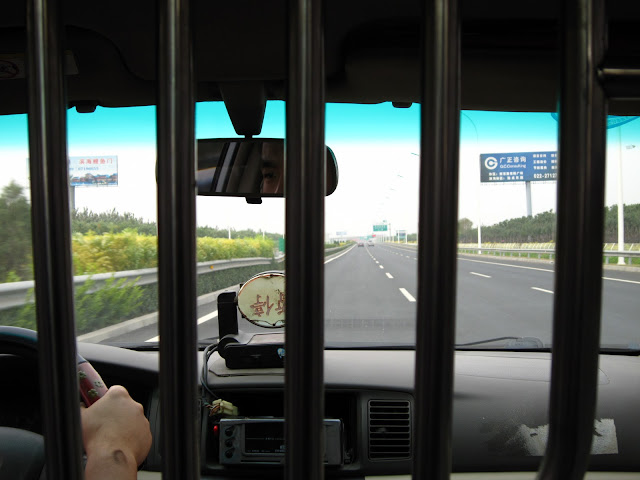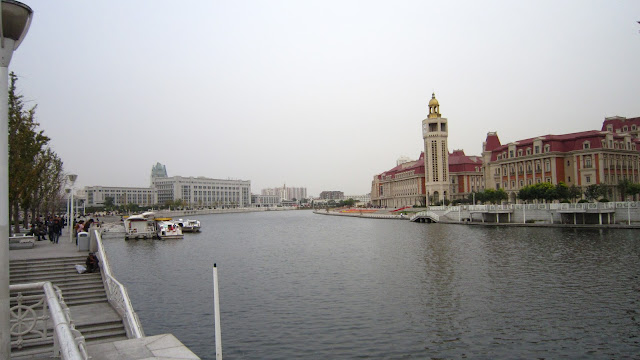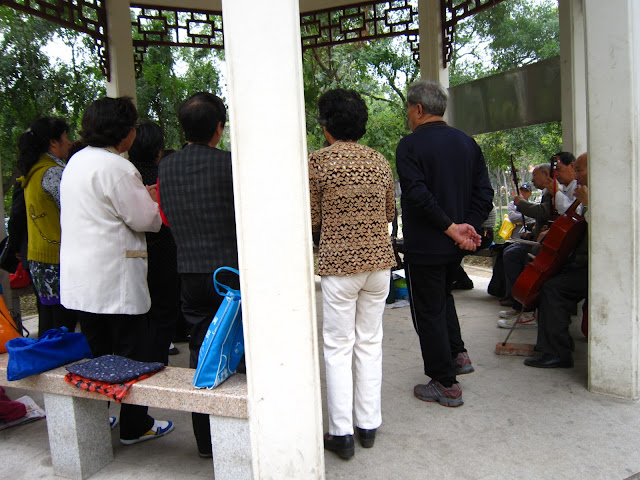23 days out of Vancouver, we landed at Tianjin to begin our personal exploration of China. Except we didn't land in Tianjin, exactly, but rather at Xingang, "New Port," a community some 35 miles from downtown Tianjin. Boats the size of ours can't get any closer than that, so our first order of business after disembarking was to get a taxi. There were many to choose from, but none of them wanted to use the meter, they wanted to bargain over the price. With some effort we agreed on one and set out on the toll road to town.
Halfway there, our driver had a flat. He had a spare, but worried about driving that far with no other spare, so he pulled out his cellphone and arranged to swap taxis with a fellow driver. Our new taxi looked like a police special, but it worked just as well and our driver found the hotel, albeit with several more cell phone calls to get directions.
 And what a hotel it was! The Astor House started in 1863, not long after the British had forced the Chinese to concede sovereignty over a portion of the city. In time, Tianjin (known as 'Tientsin' in the Wade Giles system of writing Chinese) got carved up into numerous "foreign concessions," as these areas were called, eight in all! You can click on the map below if you're curious -- the dark colors were the original areas, the pastel ones later additions. Our hotel was on the east end of the red section on the map, the British Concession. As the city grew in importance, the hotel rebuilt itself in 1886 in brick with large wooden verandas, overlooking a park across the street built at the request of the hotel. Like almost every city park we saw in China, it appeared to be well used and well cared for.
And what a hotel it was! The Astor House started in 1863, not long after the British had forced the Chinese to concede sovereignty over a portion of the city. In time, Tianjin (known as 'Tientsin' in the Wade Giles system of writing Chinese) got carved up into numerous "foreign concessions," as these areas were called, eight in all! You can click on the map below if you're curious -- the dark colors were the original areas, the pastel ones later additions. Our hotel was on the east end of the red section on the map, the British Concession. As the city grew in importance, the hotel rebuilt itself in 1886 in brick with large wooden verandas, overlooking a park across the street built at the request of the hotel. Like almost every city park we saw in China, it appeared to be well used and well cared for. Our own hotel room was in a new section built in the late 1980s, when a new lobby was created with that mural of early Tianjin seen above. We joined up with some fellow passengers from the boat who were also staying there and received a personal tour by the hotel concierge of the historic 1886 part of the hotel, including two amazing rooms.
The first was the "Herbert Hoover Room," where the future president stayed while supervising the development of coal mines as an engineer for a British firm. The second room was the "Sun Yatsen Room," named after another regular occupant after he stepped down from the post of first President of China, while he worked to unify and modernize China. We'll say more about Sun as we encounter him later in our travels. We ended our explorations in the museum downstairs. We learned about the two peace treaties signed at the hotel (one of which was commemorated by this print hanging in the Herbert Hoover Room) and of the many visits by Pu Yi, the last Emperor of China (deposed, in fact, by Sun Yatsen) who came often to tea dances in the ballroom in the 1920s. We also captured for you this reproduction of a well-furnished room of the late 1800s, curiously missing those plastic bottles of shampoo we get nowadays.
We had chosen to spend two and a half days in Tianjin in part because it is not on the standard tour of China, and in part because of its history and architecture resulting from European colonialism in the late 19th and early 20th centuries. Because it is not on that standard itinerary, we found very little in guidebooks or online about the architecture we were looking for, but architecture is such a large and public art form, it has a way of being found. As we walked along one of the main streets in the old British Concession, we saw numerous business palaces that looked like they were from London or Paris of a century ago, such as this one. Like so many others, it was built as a British (or French or German or Japanese) bank, and is now a Chinese one. BTW, if you look on that ledge between the 2nd and 3rd floors, near the right, you can see a fellow working on his hands and knees. Another fellow is up there but out of sight at the moment. Both were walking around that ledge, 30' up, without any sort of safety device whatsoever, one of many instances of things we saw in China that would drive an OSHA investigator bonkers in the US.
The buildings in the French Concession, we discovered, have largely disappeared, but they've been replaced by an enormous development, part shopping mall, part movie complex, part apartment/condo project, all in a style between French Baroque and Second Empire. It fronted the Hai He, or Hai River, and was as gorgeous up close as it was in these more distant shots, at least where it's complete -- the back sections were still half-built. In the second and third views, you can also see some of the nearby modern architecture that is going up and creating a new identity for Tianjin in architecture.
Here are two more shots of some of the more striking modern buildings. That's not distortion from a wide-angle lens, the tall building does indeed get fatter then skinnier as it rises. And those are two different buildings with upside-down U shapes.
As we continued into the Italian Concession we came to a more residential area, one filled with restaurants and with homes that have been or are in the process of becoming home to China's new wealthy. At times you had to question whether you were in China, the buildings were so un-Chinese!
Hordes of cyclists on bicycles, tricycles, and power-assisted 2- and 3-wheeled vehicles reminded us we were in China, however, along with the church we passed. Oh, the church was western enough, but all the brides hanging around the outside give it away as being Chinese.
We visited a park nearby, and found statues of musical greats -- all of them European. Although in many ways, they're universal, aren't they?
 The next day we visited a local park. It was buzzing with activity on a weekday morning. Look at all the bicycles parked outside the bike-proof gates (on the right is a second view of another set of these interesting gates). Inside, one group was singing Chinese songs accompanied by a cellist and three fellows on Chinese instruments. Nearby, four or five couples were dancing to big band dance tunes played on a boom box, while off in a corner of the park a solitary saxophonist practiced. Quite a few grandparents were walking or playing with their grandkids, and some folks just sat reading their books or their newspaper. It was fun to see a park so well-loved!
The next day we visited a local park. It was buzzing with activity on a weekday morning. Look at all the bicycles parked outside the bike-proof gates (on the right is a second view of another set of these interesting gates). Inside, one group was singing Chinese songs accompanied by a cellist and three fellows on Chinese instruments. Nearby, four or five couples were dancing to big band dance tunes played on a boom box, while off in a corner of the park a solitary saxophonist practiced. Quite a few grandparents were walking or playing with their grandkids, and some folks just sat reading their books or their newspaper. It was fun to see a park so well-loved! We had heard there was a food court worth visiting, so took a $3 taxi ride to get there (the subway system is closed at the moment as they expand from one line to two). What we discovered were twenty different restaurants, all of middling quality and almost all lacking an English menu. One had a more convincing hustler of an owner than the others as well as a menu with English translations, and we had an acceptable if middling lunch. After lunch, however, we looked down to see Sugar Man. A customer told him her sign, a dragon, and he made her a quite amazing dragon out of melted sugar!
We had heard there was a food court worth visiting, so took a $3 taxi ride to get there (the subway system is closed at the moment as they expand from one line to two). What we discovered were twenty different restaurants, all of middling quality and almost all lacking an English menu. One had a more convincing hustler of an owner than the others as well as a menu with English translations, and we had an acceptable if middling lunch. After lunch, however, we looked down to see Sugar Man. A customer told him her sign, a dragon, and he made her a quite amazing dragon out of melted sugar!We continued our exploration by going to a market a kilometer away where there was quite a collection of furs for sale. Not knowing Chinese, we never did find out how one turned the hides into something a little less like an artifact from a natural history museum. Another entrepreneur had set up a sort of carnival game on the street that attracted both players and kibbitzers. With his girlfriend standing there next to him, our contestant of course kept playing 'til he won something.
 As we headed back toward the Hai He, we passed a fairly typical apartment building complex before coming to our next shopping area, Paper and Calligraphy Street. It took some searching, but at the booth right behind Louise we found a children's book in both Chinese and English to bring back for our grandson Cedro. His dad is on Broadway in the play Chinglish right now because he is one of that rare breed of actors who speaks both Chinese and English. Never too early, right? Never mind that Cedro's learning both Japanese and Tagalog as well as English from his mom and dad. That's one busy 16-month old!
As we headed back toward the Hai He, we passed a fairly typical apartment building complex before coming to our next shopping area, Paper and Calligraphy Street. It took some searching, but at the booth right behind Louise we found a children's book in both Chinese and English to bring back for our grandson Cedro. His dad is on Broadway in the play Chinglish right now because he is one of that rare breed of actors who speaks both Chinese and English. Never too early, right? Never mind that Cedro's learning both Japanese and Tagalog as well as English from his mom and dad. That's one busy 16-month old!You'd think that was plenty of shopping streets, but the best was yet to come, a place they call Antique Street, not because you can find antiques there, but rather because it has been rebuilt to look like a shopping street in old China. Granted, it may be as authentic as Disneyland's "Main Street USA," but what people think the past was like is sometimes as powerful and important to a nation's cultural identity as what the past truly was, yes? Antique Street was filled with small shops where Louise indeed found a beautiful silk scarf, and it connected us with a truly ancient temple that gave us an interesting juxtaposition of old and new Tianjin.
We'll close with three night photos, the first of yet another shopping street with nothing antique about it whatsoever other than faux antique jeans in the trendy stores. The last two shots were taken along the Hai He. We never did see either end of this marvelous walkway that ran on both sides of the river, despite a few miles spent exploring it both by day and by night. One of the nicest things about China is that we never felt concerned for personal safety even when walking on dimly-lit walkways at night along rivers like this, or down dark alleys through poor neighborhoods day or night as we did in many other places.
The building across the river is the train station, and the next day we left on a fast train to Beijing from there after one last 2-km walk along the river pulling our suitcases. Thanks for enjoying Tianjin with us!









































No comments:
Post a Comment